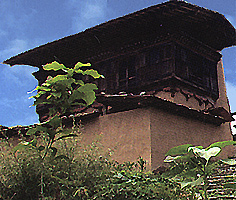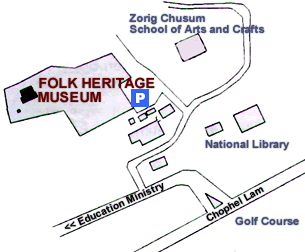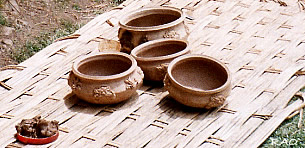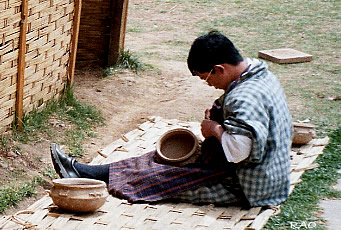| Bhutan's
Folk Heritage Museum |
 |
Bhutan Culture |
|
 |
Bhutan Information |
|
|
 |
 |
| Folk Heritage Museum in Thimphu |
| For
more information, please contact:
Phelchey
Toenkhyim, (Folk Heritage Museum)
Post
Box 233
National
Commission for Cultural Affairs,
Thimphu,
Bhutan
Telephone:
(975) 2- 327133
Fax:
(975) 2- 327132
|
|
Museum
Hours:
Monday
to Friday: 10 a.m. - 4:30 p.m.
Saturday:
10:30 a.m. - 1 p.m.
Sunday:
11:30 - 3:30 p.m.
|
|
Closed
on Government Holidays
The
Ticket sales contribute towards maintenance, research and exhibitions. |
|
| may
change without any prior notice |
top
| Phelchey
Toenkhyim (Folk Heritage Museum)
|
 |
| The Phelchey
Toenkhyim (Folk Heritage Museum) was inaugurated by Her Majesty,
the Queen Ashi Dorji Wangmo Wangchuck, who is the founder and patron
of the Museum, on 28th July 2001.
The
restoration of the museum building, the landscaping, and the procurement
of the artefacts were supported by the Swiss NGO Helvetas and the Royal Government of Bhutan. The Sustainable Development
Secretariat also contributed substantially towards the acquisition of artefacts. |
|
The Phelchey
Toenkhyim is dedicated to connecting people to the Bhutanese rural past through exhibition of items and artefacts used in rural households,
demonstrations of rural customs, traditions, habits and skills; educational
programmes for children about rural life in Bhutan, and research and proper
Document of rural life.
 |
| The
the royal collectionThe principal exhibit is the museum building itself
which is a restored three-storey traditional rammed mud and timber
house. The design and form of the house is that of an average household
in the Wang area during the mid 19th
century. The age of the structure demonstrates
the durability and performance of the building materials. |
|
From
the ground to the top floor, household objects, and typical domestic
tools and equipments tbot were used by a family in a rural housebold
during that period are put on display.
Every
visit to the Phelchey Toenkhyim is a unique experience because the aclivities
of the museum follows the seasonal dynamics in the same pattern as the
management of a rural housebold is influenced by the seasonal rhythms.
In
order to present a typical Bhutanese rural setting and flavour, paddy,
wheat and millet fields; a traditional watermill (with mill stones
that date back more than 150 years), traditional style kitchen, gardens
with vegetables that were grown and consumed over hundred years, and
the famous traditional hot stone bath complement the museum building
and the exhibitions within.
The
museum is in the process of growing some of the native people to the Bhutanese
rural past through exhibition of trees and plants that were used
for various purposes in the rural households. It is hoped that this
effort will not only keep our indigenous knowledge about the use
of natural resources alive but also create a green oasis in the heart of
the capital city.
top
The
museum can anrange the following activities within the museum premises
on request made at least a week in advance and at a nominal fee:
 |
Demonstration
Demonstration
of Traditional way of extracting oil (Markhu Tsene), brewing
Ara (Ara Kayne), roasting rice (thom dhungni) at a lump sum fee of
Nu 1500.00 (exclusive of entrance fee) for three demonstrations.
Traditional
Cuisine
Open
air buffet lunch and dinner consisting of a variety of traditional food
items from different parts of the kingdom for groups not less than five
at a time and at the rate of Nu. 250.00 per head can be arranged.
The menu for such arrangements can be obtained separately from the FoIk
Heritage Museum. |
|
| may
change without any prior notice |
The
museum is planning numerous activities to kindle public interest and generate
revenue for itself.
Source:
Brochure of Phelchey Toenkhyim |
|
more
information on Bhutan
|

|
|





